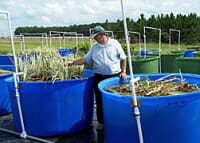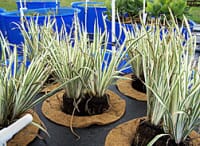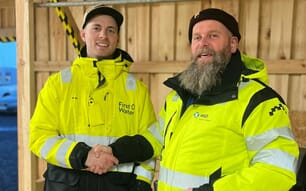To that end, Agricultural Research Service scientists in Tifton, Georgia, are testing the feasibility of using floating vegetation to remove nutrients from fishery wastewater. The long-term goal is to develop a system to treat fishery wastewater, return it to ponds for reuse, and use the nutrients to produce biomass, or plant material.

Photo: USDA

Photo: USDA
The study participants are soil scientist Robert K. Hubbard, at the ARS Southeast Watershed Research Laboratory; plant geneticist William Anderson and plant pathologist Jeffrey P. Wilson, at the ARS Crop Genetics and Breeding Research Unit, in Tifton; and University of Georgia animal science associate professors Gary Burtle and Larry Newton.
The current study is being conducted jointly by ARS and the University of Georgia’s Aquaculture Unit in Tifton. “It builds on previous research showing that vegetation can be grown on floating mats in swine-wastewater lagoons,” says Hubbard.
Wastewater from the fish-production ponds is pumped into 340-gallon aquaculture tanks. Each tank has a 10-foot-square floating mat on which the vegetation grows. “Our first objective is to find plant species that grow well in fishery wastewater,” says Hubbard.
The researchers are currently testing 12 different plant species: St. Augustinegrass, Tifton 85 bermudagrass, common bermudagrass, canna lilies, iris, bamboo, bulrush, cattail, bordergrass, napiergrass, reeds, and maidencane. “So far, the iris is the best performer,” says Hubbard.
In the second part of the study, beginning in spring 2009, researchers will determine the effects of the vegetation on water quality and the amount of nutrients removed when plant biomass is harvested, Hubbard says.
The plant material will be harvested on an as-needed basis and the plant tissue analyzed for nitrogen, phosphorus, and potassium. Harvested plant material has several potential uses. It can be transplanted, used as feedstock for energy production, or composted and used as a soil amendment.
December 2008




